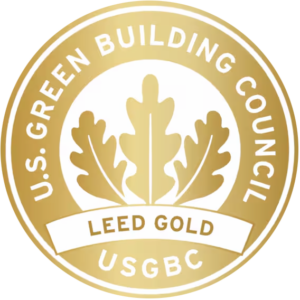
Sustainability is at the heart of everything we do at SAN.
The design and construction of New T1 reflects our industry-leading commitment to sustainability through energy and water conservation, as well as clean-air and zero-waste initiatives. Our goal is to achieve LEED Gold certification and to incorporate features that align with the City of San Diego’s Climate Action Plan.
Achieving carbon-neutrality.
The New T1 will be powered by 100% carbon-free electricity, as part of our commitment to taking urgent action to combat climate change. New photovoltaic (PV) solar panels on the roof of the terminal will bring our total on-site capacity to nearly 9.5 megawatts—enough to power the equivalent of 813 homes per day.
Once operational, the terminal will connect to the airport’s battery energy storage system, allowing us to use solar and wind power during peak demand. Passengers looking to do their part can also purchase carbon offsets through the Good Traveler Program to reduce the impact of their parking and flight.





Pursuing energy efficiency and innovation.
The façade of the New T1 ticketing hall, named the “Luminous Wave,” combines art and function with curved glass panels that will open to views and daylight from both the inside and out while also reducing sun glare and heat build-up inside the terminal.
The terminal’s heating, cooling, and power system is designed to be energy efficient, reducing carbon emissions and improving ambient air quality. An integrated heat recovery chiller and thermal energy storage system will capture, store, and reuse energy that otherwise would have been wasted while reducing carbon and particulates.
The new Parking Plaza will feature an expanded electric vehicle charging system for up to 10 percent of parking spaces. Smart Parking guidance will make parking more convenient and eco-friendly by detecting parking space availability in real-time, which will reduce emissions caused by vehicle circling. We’re also adding more than 300 bicycle parking spaces for travelers that choose to ride their bikes to and from the airport.
On the road to cleaner routes for passengers and aircraft.
A new, on-airport access road will provide a quicker, more direct route to the airport, bypassing the local traffic on North Harbor Drive. Additionally, bicyclists and pedestrians can look forward to a multi-use path along North Harbor Drive that will keep our communities connected. Passengers making a connection from local transit can use the San Diego Flyer, a free electric shuttle bus service between San Diego International Airport (SAN) and Old Town Transit Center.




At the airport, about half of our bus fleet is made up of zero-emission and alternative-fuel vehicles, and we’ve been recognized for our industry-leading conversion of airport shuttles to zero-emission technologies. Each new gate will also provide pre-conditioned air and power to parked aircraft, enabling pilots to use renewable, carbon-free power rather than their fuel-powered auxiliary power units (APU) while passengers are boarding and deplaning.
On the airfield, an underground fuel-delivery system will eliminate the need for dozens of aircraft fueling trucks to reduce air pollution, while the addition of new charging infrastructure for electric airline ground support equipment (GSE) will allow us to convert even more equipment to electric versions. A second taxiway will relieve aircraft congestion by reducing the time it takes for arriving planes to reach the terminal and departing planes to reach the runway.


Serving as water stewards.
Sustainable water management will also be a core tenet of operations. An expanded stormwater capture and reuse system, including a 1.5-million-gallon underground cistern, is designed to capture, treat, and reuse water, which would otherwise have run off into San Diego Bay. Passenger jet bridges will also have an attached condensate capture system, adding to the year-round availability of alternative water sources fed into the cistern. The captured water will be cleaned and reused in the terminal’s dual bathroom plumbing and in multiple underground storage and infiltration areas.




Outside the terminal, drought-tolerant and native vegetation landscaping will use drip and microspray irrigation methods, which help save water and reduce the energy needed from water pump operations. New stormwater infiltration systems will route some of the captured and treated stormwater back into the surrounding landscaping, significantly contributing to the environmental sustainability of the outdoor areas.
To learn more about sustainability efforts at San Diego International Airport, click here.


